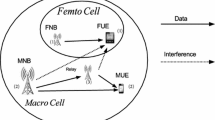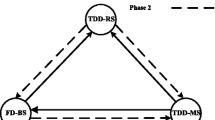Abstract
In an interference-limited system, the interference forwarding by a relay enhances the interference level and thereby enables the cancellation of the interference. In this work, interference forwarding by a half-duplex dynamic decode-and-forward (HD DDF) relay in a two-user Z-channel is considered. In the two-user Z-channel, one user is interference-limited while the other user is interference-free. The diversity gain region (DGR), which characterizes the tradeoff between the achievable diversity orders between the two users, is an appropriate performance metric for the Z-channel. Closed-form expression for the achievable DGR with the interference forwarding by the HD DDF relay is presented. The multiplexing gain regions (MGRs) where the HD DDF protocol achieves better DGR over the direct transmission scheme, full-duplex decode-and-forward (FD DF) and FD partial DF relay assisted Z- channel are identified. The HD DDF protocol is shown to achieve better DGR than the FD DF and FD PDF relay for a large range of MGR. The achievable DGRs for the HD DDF, FD DF, and FD PDF relay-assisted Z-channel and direct transmission scheme are presented for various interference levels and multiplexing gain pairs.









Similar content being viewed by others
References
Zahir, T., Arshad, K., Nakata, A., & Moessner, K. (2013). Interference management in femtocells. IEEE Communications Surveys Tutorials, 15(1), 293–311.
Costa, M. H. (1985). On the Gaussian interference channel. IEEE Transactions on Information Theory, 31(5), 607–615.
Sezgin, A., Jafar, S. A., & Jafarkhani, H. (2009). The diversity multiplexing tradeoff for interference networks. arXiv preprint arXiv:0905.2447.
Vishwanath, S., Jindal, N., & Goldsmith, A. (2003). The “z” channel. In Proceedings of the IEEE global telecommunication conference (GLOBECOM 2003) (Vol. 3, pp. 1726–1730). IEEE.
Etkin, R. H., Tse, D. N., & Wang, H. (2008). Gaussian interference channel capacity to within one bit. IEEE Transactions on Information Theory, 54(12), 5534–5562.
Lee, J., Toumpakaris, D., & Yu, W. (2011). Interference mitigation via joint detection. IEEE Journal on Selected Areas in Communications, 29(6), 1172–1184.
Laneman, J. N., Tse, D. N., & Wornell, G. W. (2004). Cooperative diversity in wireless networks: Efficient protocols and outage behavior. IEEE Transactions on Information Theory, 50(12), 3062–3080.
Dabora, R., Maric, I., & Goldsmith, A. (2008). Relay strategies for interference-forwarding. In Proceedings of the IEEE information theory workshop (ITW’2008) (pp. 46–50).
Jain, M., Choi, J. I., Kim, T., Bharadia, D., Seth, & Srinivasan, K., et al. (2011). Practical, real-time, full duplex wireless. In Proceedings of the 17th annual international conference mobile computing network (pp. 301–312). ACM.
Bharadia, D., McMilin, E., & Katti, S. (2013). Full duplex radios. SIGCOMM Computer Communication Review, 43(4), 375–386. doi:10.1145/2534169.2486033.
Khojastepour, M. A., Sabharwal, A., & Aazhang, B. (2003). On capacity of Gaussian ’cheap’ relay channel. In Proceedings of the IEEE global telecommunications conference (GLOBECOM’2003) (Vol. 3, pp. 1776–1780). IEEE.
Sirigina, R. P., & Madhukumar, A. S. (2015). On the diversity gain region for the relay assisted interference management. In Proceedings of the 81st IEEE international vehicular technology conference (VTC2015-Spring). IEEE.
Sirigina, R., & Madhukumar, A. (2016). Full-duplex decode-and-forward relay assisted interference management: A diversity gain region perspective. IEEE Transactions on Communications, 64(1), 141–152.
Azarian, K., El Gamal, H., & Schniter, P. (2005). On the achievable diversity–multiplexing tradeoff in half-duplex cooperative channels. IEEE Transactions on Information Theory, 51(12), 4152–4172.
Weng, L., Anastasopoulos, A., & Pradhan, S. S. (2011). Diversity gain regions for mimo fading broadcast channels. IEEE IEEE Transactions on Communications, 59(10), 2716–2728.
Yuksel, M., & Erkip, E. (2007). Multiple-antenna cooperative wireless systems: A diversity–multiplexing tradeoff perspective. IEEE Transactions on Information Theory, 53, 3371–3393.
Elkourdi, T., & Simeone, O. (2011). Femtocell as a relay: An outage analysis. IEEE Transactions on Wireless Communications, 10(12), 4204–4213.
Maric, I., & Goldsmith, A. J. (2011). Diversity-multiplexing tradeoff in a mimo Gaussian interference channel with a relay. In Proceedings of the IEEE international symposium on information theory (ISIT) (pp. 2622–2626).
Nafea, M. S., Seddik, K. G., Nafie, M., & Gamal, H. E. (2012). On the diversity gain region of the z-interference channels. In Proceedings of the IEEE international conference on communications (ICC) (pp. 2392–2397).
Sirigina, R. P., & Madhukumar, A. S. (2016). On the symbol error rate and diversity gain region of the relay-assisted z-channel. IEEE Transactions on Wireless Communications, 15(3), 1965–1978.
Sirigina, R. P., & Madhukumar, A. S. (2015). Interference mitigation in z-channel and relay-assisted z-channel: A diversity gain region perspective. Wireless Networks. doi:10.1007/s11276-015-1125-7.
Sirigina, R. P., & Madhukumar, A. S. (2015). DMT for the relay assisted interference cancellation over Nakagami-m fading channel. In IEEE 81st vehicular technology conference (VTC Spring) (pp. 1–5). IEEE.
Karmakar, S., & Varanasi, M. K. (2010). The diversity-multiplexing tradeoff of the mimo z interference channel. In Proceedings of the IEEE international symposium on information theory (ISIT) (pp. 2188–2192).
Kwon, T., Lim, S., Choi, S., & Hong, D. (2010). Optimal duplex mode for DF relay in terms of the outage probability. IEEE Transactions on Vehicular Technology, 59(7), 3628–3634.
Zheng, L., & Tse, D. N. C. (2003). Diversity and multiplexing: A fundamental tradeoff in multiple-antenna channels. IEEE Transactions on Information Theory, 49(5), 1073–1096.
Tse, D., & Viswanath, P. (2005). Fundamentals of wireless communication. Cambridge: Cambridge University Press.
Boyd, S. P., & Vandenberghe, L. (2004). Convex optimization. Cambridge: Cambridge University Press.
Acknowledgments
The authors would like to thank the editor and the anonymous reviewers whose feedback helped us to improve the quality of the work.
Author information
Authors and Affiliations
Corresponding author
Appendix: Proof of Theorem 1
Appendix: Proof of Theorem 1
Let \(v_{ij}\), for \(\left( i,j\right) \in \left\{ 1,2,3\right\}\), be the exponential order of the channel gain \(h_{ij}\) between the terminals i and j. It is defined as [25]
The probability density function (pdf) of \(v_{ij}\) is [14]
First, few notations are introduced. Later, using these notations, the achievable DGR with the HD DDF protocol is presented. Let \({\mathbf{r}} = [r_1 \quad r_2]\) and \(r_s = r_1+r_2\). Let \({\mathcal{G}}_i({\mathbf{r}},\beta _{21},f)\), for \(i \in \left\{ 1,2,3\right\}\), and \({\mathcal{G}}_4({\mathbf{r}},f)\) be defined as
1.1 Calculation of \(d^{DDF_{hd}}_{FUE}\):
The FUE is in outage if any one of the inequalities in (6) and (7) is not satisfied. Let \({\mathcal{O}}^{DDF_{hd}}_{FUE,1}\) and \({\mathcal{O}}^{DDF_{hd}}_{FUE,2}\) be the outage events related to the inequalities (6) and (7), respectively. Let \(Pr\left( {\mathcal{O}}^{DDF_{hd}}_{FUE,i}\right)\), for \(i=\left\{ 1,2\right\}\), be the probability of the outage corresponding to the event \({\mathcal{O}}^{DDF_{hd}}_{FUE,i}\). Using the union bound, \(Pr\left( {\mathcal{O}}^{DDF_{hd}}_{FUE}\right)\) can be evaluated as
Here, \({\mathbf{h}} = [h_{11}\;h_{21}\;h_{31}]\). Let
Using (17), (37) and (40), the achievable DMT at the FUE with HD DDF protocol can be obtained as shown in (12). The calculation of \(d^{DDF_{hd}}_{FUE,i}\), for \(i=\left\{ 1,2\right\}\) is presented below.
1.1.1 Evaluation of \(d^{DDF_{hd}}_{FUE,1}\)
The high SNR approximation of \({\mathcal{O}}^{DDF_{hd}}_{FUE,1}\) can be written as
As shown in [26], the \(Pr\left( {\mathcal{O}}^{DDF_{hd}}_{FUE,1}\right)\) at high SNR can be obtained as
From (40) and (42), the \(d^{DDF_{hd}}_{FUE,1}\) can be obtained as shown in (14).
1.1.2 Evaluation of \(d^{DDF_{hd}}_{FUE,2}\)
The \(Pr\left( {\mathcal{O}}^{DDF_{hd}}_{FUE,2}\right)\) can be evaluated as
Here, \(f < 1\) means, the relay can decode and retransmit the signal, and the FUE can make use of the retransmitted signal. \(f = 1\) means, the relay fails to decode the data from the MNB. In the HD DDF protocol, if the relay fails to decode the data, the FUE is declared to be in outage. Hence,
The exponential orders of \(Pr(f =1 )\), \(Pr\left( {\mathcal{O}}^{DDF_{hd}}_{FUE,2}|f < 1\right)\) and \(Pr(f <1)\) are defined as
Using (40), (43), (44), (45), (46) and (47), \(d^{DDF_{hd}}_{FUE,2}\) can be obtained as shown in (15). Next, \(d^{DDF_{hd}}_{Relay}\), \(\tilde{d}^{DDF_{hd}}_{Relay}\) and \(\tilde{d}^{DDF_{hd}}_{FUE,2}\) are evaluated.
From (5), the \(Pr(f =1 )\) can be evluated as
From (45) and (48), the \(d^{DDF_{hd}}_{Relay}\) can be evaluated as in (16). \(Pr(f<1)\) can be evaluated as
Using (48) and (49), it can be shown that \(\tilde{d}^{DDF_{hd}}_{Relay} = 0\).
Next, The evaluation of \(\tilde{d}^{DDF_{hd}}_{FUE,2}\) is presented.
For \(f < 1\), the high SNR approximation of (39) can be written as
Using the Laplace integration technique [25], \(\tilde{d}^{DDF_{hd}}_{FUE,2}\) can be obtained as
In the above problem, the equality constraint is obtained from the high-SNR parametrization of (5).
As the constraints related to \(v_{23}\) and \([v_{11}\; v_{21}\; v_{31}]\) are not coupled, the above optimization problem can be equivalently written as [27]
The above problem can be equivalently written as
The inner optimization problem, \(d_{inner}(f)\), can be solved by dividing the constraint region into several subregions as follows.
-
Case - I: \([1-v_{11}]^+ > [\beta _{21}-v_{21}]^+\) and \([1-v_{11}]^+ > [1-v_{31}]^+\).
-
Case - II: \([\beta _{21}-v_{21}]^+ > [1-v_{11}]^+\) and \([\beta _{21}-v_{21}]^+ > [1-v_{31}]^+\).
-
Case - III: \([1-v_{31}]^+ > [1-v_{11}]^+\), \([1-v_{31}]^+ > [\beta _{21}-v_{21}]^+\), and \([1-v_{11}]^+ > [\beta _{21}-v_{21}]^+\).
-
Case - IV: \([1-v_{31}]^+ > [1-v_{11}]^+\), \([1-v_{31}]^+ > [\beta _{21}-v_{21}]^+\), and \([1-v_{11}]^+ < [\beta _{21}-v_{21}]^+\).
First, \(d_{inner}(f)\) needs to be evaluated for each case. Later, the outer optimization, i.e., the minimization over f, needs to be done for each case. Let \(d^{FUE}_{I}\), \(d^{FUE}_{II}\), \(d^{FUE}_{III}\), and \(d^{FUE}_{IV}\) be the optimal values corresponding to Case I, Case II, Case III, and Case IV, respectively. As the calculation of these parameters involve the standard linear programming techniques, the evaluation is not shown here. The \(\tilde{d}^{DDF_{hd}}_{FUE,2}\) can be obtained by taking the minimum of all these values as
where
1.2 Achievable DMT at the MUE with the HD DDF protocol
From (8), the \({\mathcal{O}}^{DDF_{hd}}_{MUE}\) can be defined as
The \(Pr\left( {\mathcal{O}}^{DDF_{hd}}_{MUE}\right)\) can be written as
If the relay cannot decode the data within the frame duration, outage is declared at the MUE . Hence,
\(Pr(f=1)\) and \(Pr(f < 1)\) can be obtained from (48) and (49) respectively. Hence, only \(Pr\left( {\mathcal{O}}^{DDF_{hd}}_{MUE}|f<1\right)\) needs to be evaluated. Let
As in the case of the FUE, the achievable DMT at the MUE can be written as in (13).
In (13), only \(\tilde{d}^{DDF_{hd}}_{MUE}\) needs to be evaluated. It can be evaluated as
This problem can be equivalently written as
The inner optimization problem can be solved as
Let \(d^{MUE}_{I}\), \(d^{MUE}_{II}\) and \(d^{MUE}_{III}\) be the achievable DMTs corresponding to the above three cases. Then \(\tilde{d}^{DDF_{hd}}_{MUE}\) can be calculated as
where
Rights and permissions
About this article
Cite this article
Sirigina, R.P., Madhukumar, A.S. On the diversity gain region of the dynamic decode-and-forward relay-assisted Z-channel. Wireless Netw 24, 395–407 (2018). https://doi.org/10.1007/s11276-016-1339-3
Published:
Issue Date:
DOI: https://doi.org/10.1007/s11276-016-1339-3




